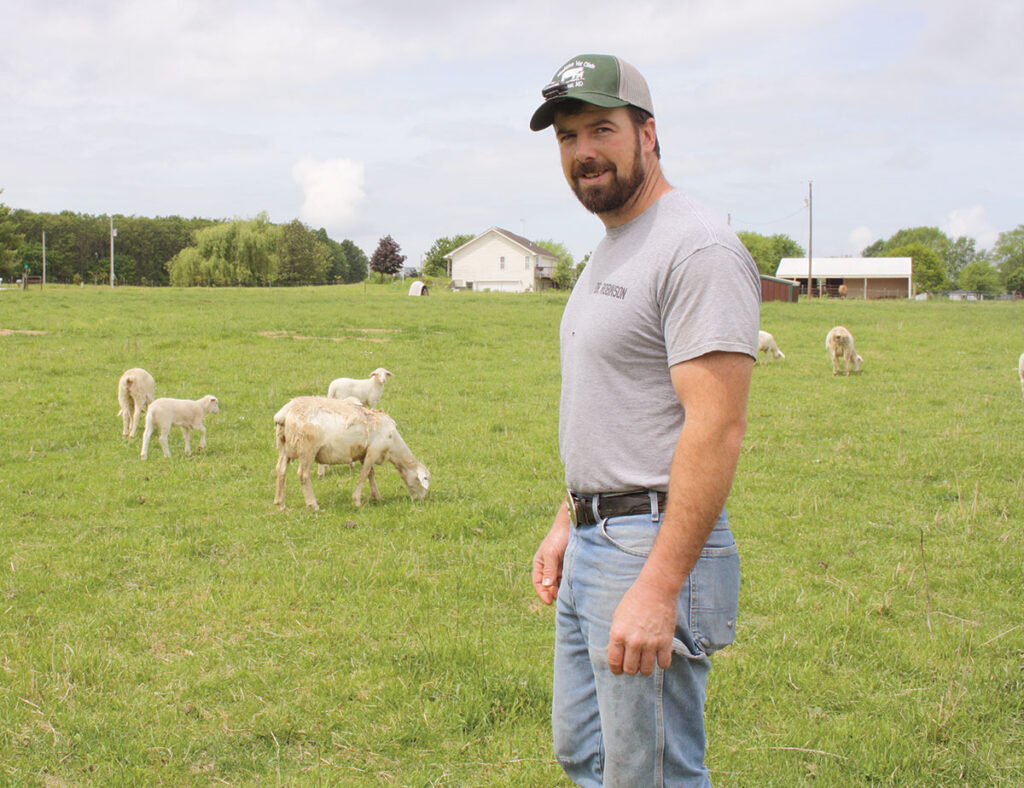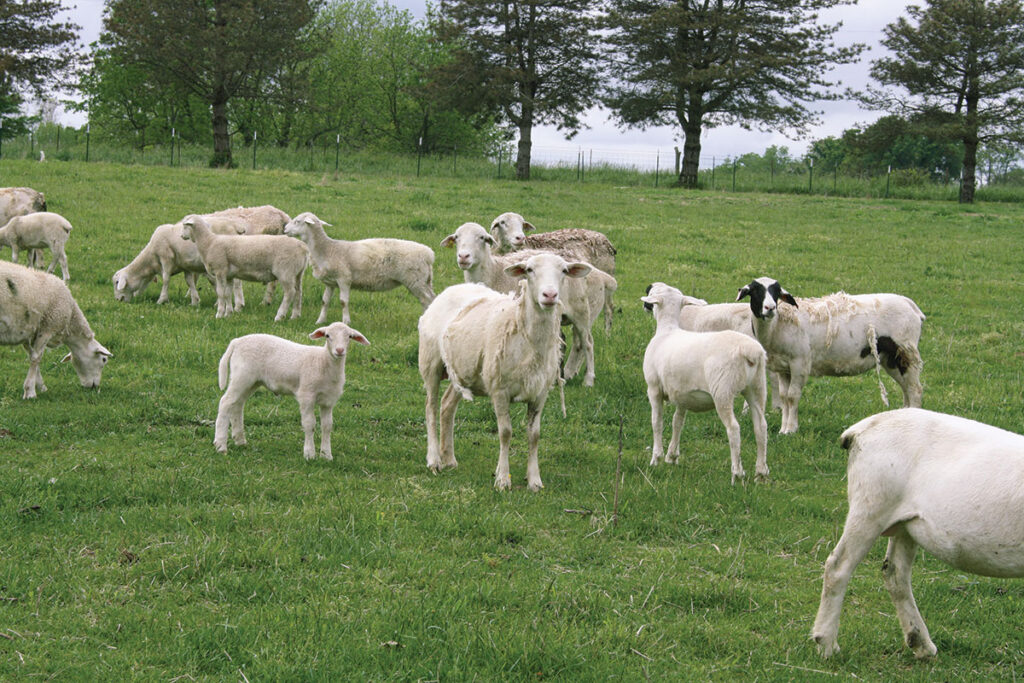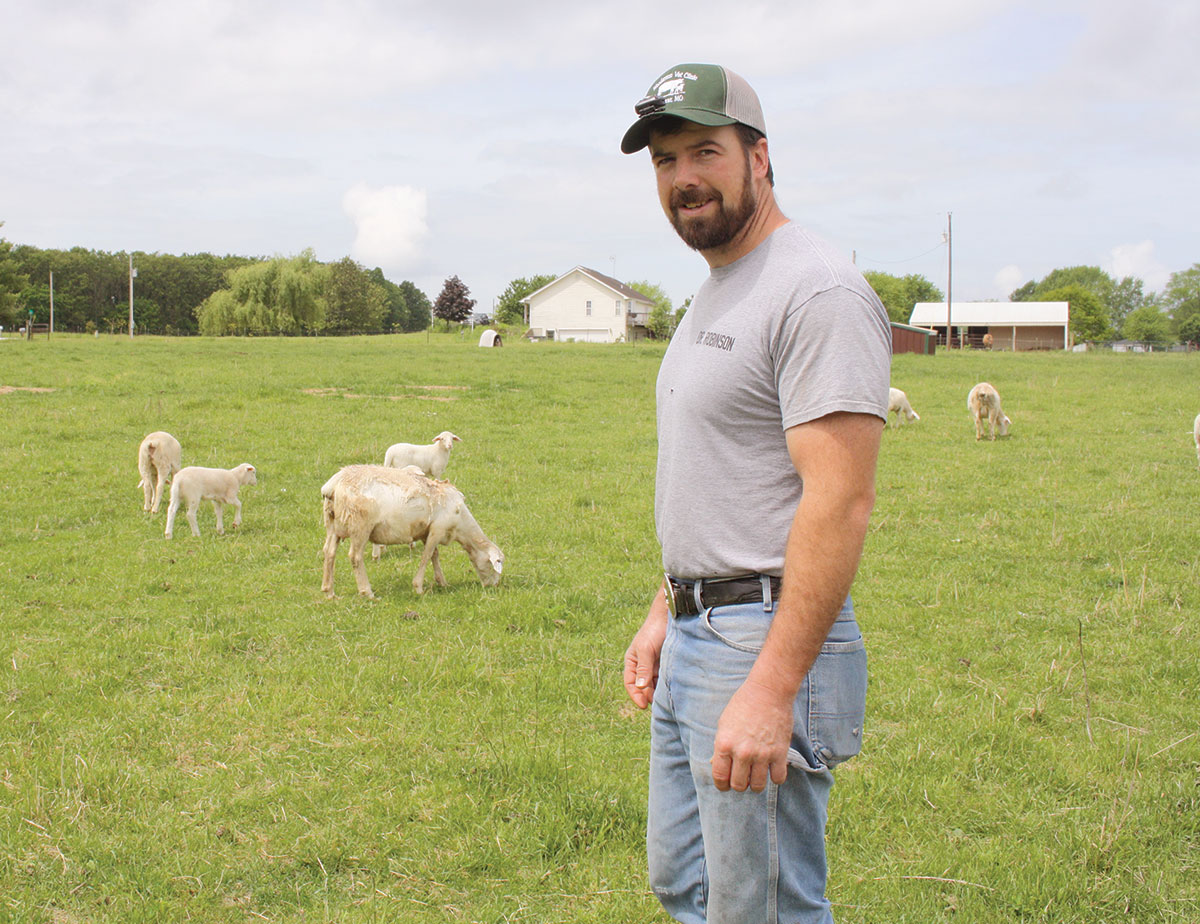
White Dorper producer Charlie Robinson traces his with flock with NSIP
Charlie Robinson was introduced to Katahdin and Dorper sheep in high school through a neighbor, and he had a few head of his own.
After a few years, it was off to college, then to veterinary school, so his sheep operation stopped. As time went on, Charlie graduated from vet school and became a partner in Wooderson Vet Clinic in Bolivar, Mo. About a year after arriving in Polk County, Charlie partnered with a client on a Dorper operation; he was back in the sheep business. The partnership, however, dissolved after a year and a half, leaving Charlie with a flock of sheep and no pasture. As luck would have it, another client had gotten out of the goat business, so Charlie rented that farm; it was, however, a little too far from home. He then worked with a pasture-poultry operation to graze down paddocks. It was going well, but changes were on again on the horizon.
“When the market went sky-high this winter, I thought someone else needed to own those ewes,” Charlie said.
Charlie still has a flock of about 30 White Dorpers and plans to expand to about 200 ewes through a rotational grazing program created by working with the Natural Resources Conservation Service on his 80-acre farm near Bolivar. Charlie is retaining most of his ewe lambs to help build his flock. He also plans to restock the paddocks of the poultry operation this summer. Due to predator issues, Charlie said his current plan is to buy ewes, breed them in December/January, then sell them as bred ewes.
“The end goal of these sheep is at the consumer level. The producers I am selling breeding stock to need rams that will deliver on the rail,” Charlie said. “The sheep that rotate around the chicken barns are commercial, but the goal of Doc Robinson Dorpers is to produce breeding stock for commercial producers so they can produce high-quality slaughter lambs for the consumer. There are a portion of the seedstock lambs that don’t make the cut for breeding stock and they go to slaughter. Dopers cut out at a higher percentage, have larger loins, bigger rumps, and can do it all on grass.”
Breeding the dams and sires of those high-quality meat animals is where Charlie’s flock comes into the equation.
“We are getting so far away from normal production and getting into the show ring so much that there are almost two different breeds. Coddling a show lamb is great for 4-H kids because they need to learn responsibility, but not so great for a producer who wants to make money. I’m not saying there aren’t show rams out there that can produce lambs that make money; the problem is they don’t have any reliable data. Phenotype is an important aspect of evaluating the animal but we need the production data to complete the picture.”
Through the National Sheep Improvement Program (NSIP), Charlie tracks genetic data and compares it to other producers’ lambs, especially those with the same genetic lines.
“I want to buy breeding stock from someone on NSIP who has high-quality animals, with good numbers on birth weight, weaning weight, post-weaning weight (generally at about 120 days of age) and eye muscle depth.”
Bigger isn’t always the better when collecting data in White Dorpers. Data shows weaning weights are inversely correlated to eye-muscle depth in the breed.
“Ewes with high eye-muscle depth don’t often have high weaning weights, that’s what we are striving for though. It can be done, it’s just hard to do,” Charlie explained. “We’ve also found that muscle depth carries a lot of genes for maternal traits. Typically, the higher eye muscle is the more maternal-style animals, while those with higher weaning weight will be higher terminal-style animals. It makes sense because if you are going to breed to a terminal stud, you want a higher weaning weight.”
To build his flock, Charlie has sought his breeding stock from White Dorper breeder Paul Lewis of the state of Oregon. Charlie considers Paul to be one the top breeders of “non-coddled” White Dorpers in the U.S.
Paul, Charlie explained, has 600 head of White Dorpers roaming the “tundra” of Oregon, where rainfall is light and conditions are sometimes harsh. Paul has been breeding Dorpers long enough for his genetics to be found in both the Australian Lamb Plan system and NSIP. Dorpers are a composite breed of horned Dorsets and Fat Tailed Persian sheep originating in South Africa. Due to embargoes, U.S. breeders can not obtain genetics directly from South Africa, with most coming from Australia.
“In White Dorpers, when you turn in your data on NSIP, they go back and send it to Lamb Plan, which runs equations that spits out the data for the EBVs (Estimated Breeding Values),” Charlie said. “For the last two years, I haven’t bought anything outside of his stock because he’s the only place I can go to get those records, outside of flying to Australia, buying a couple of rams, collecting them and then importing the semen, which is what Paul does. What I buy are those AI-sired rams. He has a lot of rams from his breeding, and I am looking at one of those rams for next year, and it’s in the top 5 percent of the breed for eye-muscle depth.”
Because his sheep are not destined to be show animals, Charlie wants them to perform the way the breed was intended.

“I want to preserve that White Dorper style that will work on pasture, with minimal human interaction,” Charlie said. “None of my ewes lamb in jugs, none of them have special care. These ewes do not need, unless it’s the extreme cold like we had in February, coddling. Ewes that lamb on pasture are better mothers, are probably better at staving off predators, and the lambs are hardier all around.” He added he did bring in his ewes that were lambing during the extreme cold blast more for his own compfort than that of the ewes and lambs.
His “no coddling” approach to sheep production also carries over to the ram side.
“The pasture-raised ram may grow slower, but he will still reach the same size at maturity. The ram’s goal is to breed ewes, not be 60 pounds at a month old,” Charlie said.
Ewes receive feed only before breeding to improve the chances of twins, and while nursing. After lambs are weaned at 90 days, it’s back to grass.
When selling breeding stock, Charlie is armed with NSIP data, ready to show the potential of each animal.
“The data is the most important thing we have,” Charlie said. “NSIP is keeping track of the pedigree of that animal to compare to other flocks, and develop your accuracy. Lambs in Australia being raised in the outback are being compared to Paul Lewis’ lambs in the tundra of Oregon, and to my lambs raised in Southwest Missouri on fescue. We are getting a look at how good our genetics are because of the vast array of areas they are being raised.”
Demand has been good for Charlie’s rams, so good he sold two the three rams he planned to use for his breeding program, including a ram that is in the top 5 percent of the breed for maternal weaning weights.
“I sold him with the agreement I could collect semen from him,” Charlie said. “His daughters are really, really good, and I want to keep his genetics around. I can’t replace his production numbers.”
Ewes typically lamb at about 2 years of age, and lambs are offered a creep feed at about 2 months. Creep feeders, however are limited feeders so Charlie can control the amount fed per day. While feed is available, his lambs eat very little, and if the grass is in good shape, he may not offer any to weaned lambs.
As he builds his operation, Charlie’s plans for the future are clear.
“My goal is to produce a line of rams that are super-high weaning weight rams, and I would like to have a line of super-high eye-muscle depth rams,” he said. “Then I want the rest to be right in the middle, just solid all-around rams that have weaning weights in the top 20 percent and still have a 2 for eye-muscle depth so they can be used for about anything, for retaining ewes or butcher lambs. The ideal is to walk out in a pasture of 20, 30 rams and show people rams that will produce those lambs that will sell at 60 pounds at the sale barn, and here’s 10 to pick from. If they want that ram that will improve their flock all around, then here’s the line you need to go with. We have to have something to look at rams that isn’t just phenotype. That’s all we’ve had for a long time.”
Charlie added that the sheep market in the Ozarks has tremendous opportunities ahead.
“We are developing a market for larger slaughter lambs than the normal 60 pounder at a Droper specific packer that offers value added programs such as all natural, free range and organic. These labels lead to higher premiums on our high quality carcasses,” he said.







